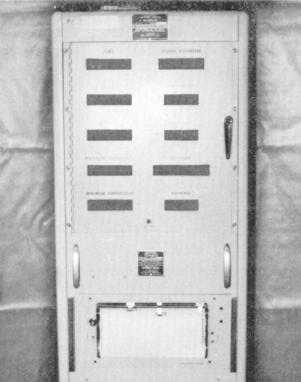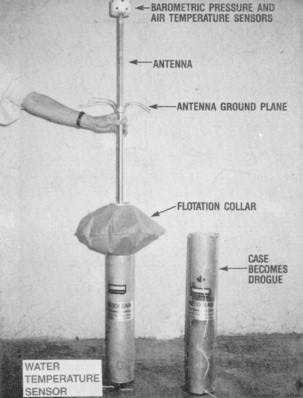either moored in a permanent location or drifting buoys.
Routinely deployed by aircraft since 1989, drifting
meteorological buoys (fig. 2-6) are sonobuoy-size
weather stations that provide wind, air pressure, air and
sea surface temperature, wave period, and sea
temperature/salinity depth profiles to collection points
via satellite.
As an observer, you will have little opportunity to
see a fully automatic weather station, since no observer
support is required. However, you will use
observations and data transmitted by these stations. We
discuss these products in later modules.
REVIEW QUESTIONS
Q1. How often are ASOS observations updated?
Q2. How does the ASOS system detect precipitation?
Q3. What system does SMOOS interface with?
Q4. The SMOOS can detect clouds at what maximum
height?
Q5. How do drifting and moored oceanographic
buoys relay information to collection sites?
SEMIAUTOMATIC WEATHER STATION
LEARNING OBJECTIVE: Identify the major
components and characteristics of the
AN/GMQ-29 semiautomatic weather station.
At some observing stations, the primary-use
weather observation equipment is still the AN/GMQ-29
automatic weather station. Although called the
Automatic Weather Station when first introduced, this
equipment earned the more popular term semiautomatic
weather station after truly automatic weather
observations were introduced. First operated in 1975,
the AN/GMQ-29 uses electronic and electromechanical
sensors to measure temperature, pressure, precipitation,
and winds. This equipment was installed at all Naval
Meteorology and Oceanography detachments,
facilities, and centers. The manual that describes
operating procedures for this equipment is
NAVAIR 50-30 GMQ-29-2, Handbook of Operation,
Service and Overhaul Instructions with Illustrated
Parts Breakdown for the Automatic Weather Station
(AN/GMQ-29A). There are two major groups of
equipment in the system: the display group and the
sensor group. Figure 2-7 shows the display group,
Figure 2-6.—Drifting buoy.
Figure 2-7.—AN/GMQ-29 display group.
2-5





